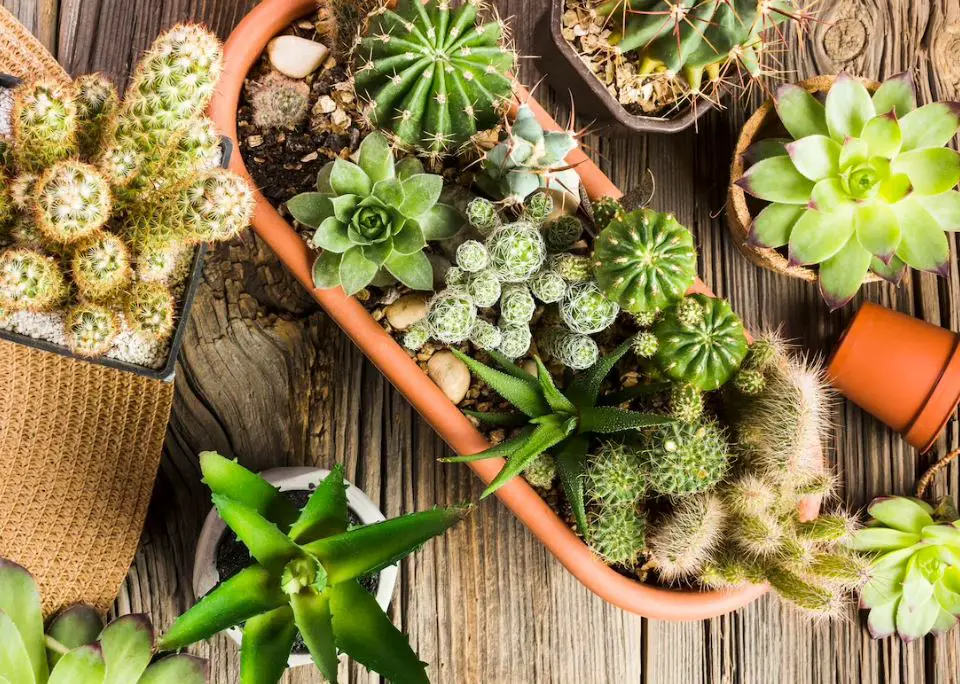Growing a Cactus Collection Indoors: A Guide to Success

Welcome to the fascinating world of indoor cactus cultivation! Whether you’re an experienced plant enthusiast or a beginner looking to add some unique greenery to your home, growing a cactus collection indoors can be an exciting and rewarding endeavor.
These desert plants not only bring a touch of exotic beauty but also require minimal maintenance, making them ideal for busy individuals. In this comprehensive guide, we’ll explore everything you need to know to create a thriving cactus collection within the cozy confines of your home.
Choosing the Right Cacti for Indoors
Before diving into the wonderful world of cacti, it’s essential to select the right species for indoor growth. Not all cacti thrive in indoor environments, so it’s crucial to choose varieties that are well-suited to living inside your home. Let’s explore some popular indoor cacti options and their unique characteristics.
Miniature Cacti: Tiny Treasures
Miniature cacti, such as Mammillaria species, are excellent choices for indoor collections. These petite beauties feature charming globular or cylindrical shapes, often adorned with fascinating spines and colorful flowers. They require less space and can be easily accommodated on windowsills or shelves.
Columnar Cacti: Majestic Statements
If you have ample vertical space and prefer taller cacti, consider columnar varieties like the Cereus genus or the iconic Echinopsis pachanoi (San Pedro cactus). These majestic cacti can add a touch of drama to your indoor oasis, resembling living sculptures that captivate the eye.
Epiphytic Cacti: Unique Hanging Delights
Epiphytic cacti, such as the enchanting Rhipsalis genus, are perfect for those who love hanging plants. These cacti possess an ethereal quality, cascading gracefully from hanging baskets or mounted on driftwood. They thrive in low-light conditions, making them an excellent choice for rooms with limited sunlight.
Cacti for Flower Enthusiasts
For cacti lovers who appreciate stunning blooms, certain species are known for their vibrant and show-stopping flowers. The Epiphyllum and Schlumbergera genera, commonly known as Orchid Cacti and Christmas Cacti, respectively, are popular choices. These cacti produce stunning flowers in various colors, adding a burst of beauty to your indoor space.
Creating the Perfect Indoor Environment
Cacti have specific environmental requirements to thrive indoors. By providing the right conditions, you can ensure the health and longevity of your cactus collection. Let’s delve into the key elements for creating the perfect indoor environment for your desert darlings.
Sunlight: Embracing the Desert Glow
Sunlight is crucial for the growth and vitality of cacti. Position your cacti near windows or in areas that receive abundant sunlight.
South or east-facing windows are ideal, as they provide the right balance of intensity and duration without scorching the plants. However, be cautious of intense midday sun, as it can lead to sunburn.
Temperature: Mimicking Desert Conditions
Cacti are well-adapted to arid environments, so it’s important to replicate those conditions indoors.
Most cacti thrive in temperatures between 65°F (18°C) and 85°F (29°C) during the day, with slightly cooler temperatures at night. Avoid exposing them to extreme temperature fluctuations or drafts, as these can harm the plants.
Humidity: Embracing the Dryness
One advantage of growing cacti indoors is that you don’t need to worry about high humidity levels. Cacti prefer drier conditions, so typical indoor humidity is usually suitable. Avoid placing cacti near humidifiers or in steamy areas like bathrooms, as excessive moisture can lead to rot.
Air Circulation: A Breath of Fresh Air
Proper air circulation is essential for cacti health. Stagnant air can promote fungal growth, so ensure adequate ventilation in the room where your cacti reside.
Gentle air movement from ceiling fans or open windows can help simulate the natural breeze cacti are accustomed to in their native habitats.
Artificial Lighting: Supplementing Natural Sunlight
In cases where natural sunlight is limited or insufficient, you can supplement it with artificial lighting. LED grow lights are an excellent choice for providing the right spectrum and intensity of light.
Position the lights close to the cacti and ensure they are on for about 12 to 14 hours a day, replicating the duration of daylight in their natural habitat.
Potting and Soil Considerations
Selecting the right pots and soil for your cacti is crucial for their well-being. Cacti have specific requirements when it comes to their rooting environment, so let’s explore the essential considerations for potting and soil selection.
Pot Selection: Size and Drainage
When choosing pots for your cacti, opt for containers with drainage holes to prevent waterlogged soil. Select pots that are slightly larger than the root ball, allowing room for growth. Avoid oversized pots, as excess soil can retain moisture and lead to root rot.
Soil Mix: Sandy and Well-Draining
Cacti thrive in well-draining soil that mimics their native desert habitats. Prepare a suitable soil mix by combining regular potting soil with coarse sand and perlite or pumice. This mixture provides the ideal balance of moisture retention and drainage necessary for healthy root development.
Repotting: When and How
Knowing when and how to repot your cacti is crucial for their long-term health. Learn to recognize the signs that indicate your cacti have outgrown their current pots, and follow the proper repotting techniques to ensure a seamless transition for your plants. Repotting is typically done every two to three years or when the roots outgrow the pot.
Terrariums: Creating Miniature Cactus Ecosystems
Terrariums can be a unique and visually appealing way to display small cacti. These enclosed glass containers create a mini-ecosystem, providing controlled conditions for the cacti.
When creating a cactus terrarium, it’s essential to choose small, slow-growing cacti and use a well-draining soil mix. Additionally, ensure proper airflow within the terrarium to prevent excessive humidity.
Watering and Care
Proper watering and care are vital to the health of your indoor cactus collection. While cacti are known for their ability to withstand drought, they still require periodic watering and attention. Let’s explore some essential guidelines for watering and caring for your indoor cacti.
Watering Frequency: The Drought-Loving Plants
Cacti have adapted to survive in arid conditions, so they don’t require frequent watering. It’s crucial to allow the soil to dry out completely between watering sessions to prevent overwatering, which can lead to root rot.
The frequency of watering depends on factors such as temperature, humidity, and the specific cactus species.
Watering Technique: Soaking and Draining
When it’s time to water your cacti, employ the soak-and-drain method. Place the pot in a sink or tray filled with water and allow the soil to absorb moisture from the drainage holes.
Once the topsoil feels moist, remove the pot from the water and let it drain thoroughly. Avoid leaving the cacti sitting in standing water, as this can lead to root rot.
Seasonal Variations: Adjusting Watering Routine
Cacti have natural growth cycles that influence their watering needs. During the active growing season, typically spring and summer, cacti require more frequent watering.
As they enter dormancy in fall and winter, watering should be reduced to allow for a period of rest. Observe your cacti’s growth patterns and adjust the watering routine accordingly.
Fertilizing: Boosting Growth
Cacti generally require minimal fertilization. During the active growing season, you can provide a balanced liquid fertilizer diluted to half the recommended strength once a month.
Avoid fertilizing during dormancy, as cacti do not actively grow during this period. It’s essential to avoid overfertilization, as excessive nutrients can harm the plants.
Pruning and Grooming: Handling Spines and Pests
Pruning and grooming your cacti not only helps maintain their shape but also keeps them healthy and free from pests. Use protective gloves or tools to handle spiny cacti and carefully remove any dead or damaged parts.
Regularly inspect your cacti for signs of pests, such as mealybugs or scale insects, and promptly treat any infestations to prevent further damage.
Troubleshooting Common Issues
Despite their resilience, cacti can face certain challenges when grown indoors. Understanding and addressing these common issues will help ensure the success of your cactus collection. Let’s explore some troubleshooting tips for common problems.
Sunburn: Protecting from Excessive Sunlight
Too much direct sunlight can cause sunburn on cacti, resulting in unsightly patches or discoloration. If you notice signs of sunburn, such as brown or discolored spots, move your cacti to a slightly shadier location and gradually reintroduce them to brighter light.
Overwatering: The Peril of Excess Moisture
Overwatering is one of the most common issues that can affect indoor cacti. If you notice signs of overwatering, such as yellowing, softening, or wilting stems, adjust your watering routine immediately. Allow the soil to dry out completely before watering again and ensure proper drainage in the pots.
Root Rot: Preventing and Treating
Root rot can occur when cacti are exposed to consistently wet or waterlogged soil. If you suspect root rot, carefully remove the affected cacti from the pot, trim away any rotted or mushy roots, and repot them in fresh, well-draining soil. Adjust your watering habits to prevent future occurrences.
Pests: Keeping Unwanted Visitors Away
Pests, such as mealybugs, scale insects, or spider mites, can occasionally infest indoor cacti. Regularly inspect your plants for signs of pests, such as webs, sticky residue, or discolored spots.
If you notice any issues, isolate the affected plants and treat them with an appropriate insecticidal soap or horticultural oil. Maintaining good air circulation and avoiding overwatering can also help deter pests.
Dormancy: Understanding Natural Growth Cycles
During the winter months, many cacti enter a period of dormancy. Growth slows down, and watering requirements decrease. It’s important to respect this natural cycle and adjust your care routine accordingly.
Reduce watering frequency and provide cooler temperatures to allow your cacti to rest and prepare for their next growth phase.
Conclusion
Growing a cactus collection indoors can be a delightful and rewarding experience. By selecting the right cacti, creating a suitable indoor environment, providing proper potting and soil conditions, and following appropriate care routines, you can enjoy the beauty and resilience of these desert wonders within the comfort of your own home.
Remember to regularly monitor your cacti’s health, adjust care as needed, and take the time to appreciate the unique charm and character these plants bring to your living space.
Frequently Asked Questions (FAQs)
Can I grow cacti in low-light conditions?
Yes, there are cacti species, such as certain Rhipsalis varieties, that can thrive in low-light environments. These cacti have adapted to shade and are perfect for rooms with limited sunlight.
How often should I water my indoor cacti?
Cacti generally require infrequent watering. It’s crucial to allow the soil to dry out completely between watering sessions to prevent overwatering, which can lead to root rot. The frequency of watering depends on factors such as temperature, humidity, and the specific cactus species.
How do I prevent pests from infesting my indoor cacti?
To prevent pests, regularly inspect your cacti for signs of infestation, such as webs, tiny insects, or discolored spots. If you notice any issues, isolate the affected plants and treat them with an appropriate insecticidal soap or horticultural oil. Maintaining good air circulation and avoiding overwatering can also help deter pests.
Can I fertilize my indoor cacti?
Cacti require minimal fertilization. During the active growing season, you can provide a balanced liquid fertilizer diluted to half the recommended strength once a month. However, it’s essential to avoid overfertilization, as excessive nutrients can harm the plants.
Why are my cacti turning yellow?
Yellowing of cacti can indicate various issues, such as overwatering, poor drainage, nutrient deficiency, or pests. Assess the watering routine, soil conditions, and check for signs of pests. Adjust the care accordingly to address the underlying cause of the yellowing.
Also READ!
The Art of Crafting Indoor Bonsai Forests: A Guide to Creating Miniature Ecosystems. READ:homeimprove360.com/crafting-indoor-bonsai-forests-guide/
